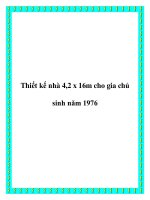4 2 drilling hydraulics
Bạn đang xem bản rút gọn của tài liệu. Xem và tải ngay bản đầy đủ của tài liệu tại đây (238.57 KB, 26 trang )
Network of Excellence in Training
Bit Hydraulics
© COPYRIGHT 2001, NExT.
All Rights Reserved
Hydraulics
• Lecture Contents;,
– Lecture Objectives,
– Basic concepts of Hydraulic,
– Pressure Losses and ECD,
– Bit nozzle selection,
– Hydraulic optimization.
2
© COPYRIGHT 2001,
.
All Rights Reserved
Hydraulics
• Lecture Objectives;
– By the end of this lecture YOU should be able
to:
• Understand basic concept of bit hydraulics,
• Describe various pressure losses
• Factors effecting ECD
• Select bit nozzles to optimize bit hydraulics
3
© COPYRIGHT 2001,
.
All Rights Reserved
Hydraulics
– Fluid Circulation:
• Circulation across the bit face must be designed to
remove the cuttings efficiently and also cool the bit
face,
• These requirements may be satisfied by increasing
the fluid flowrate,
• The increased fluid flowrate may however cause
excessive erosion of the face and premature bit
failure.
4
© COPYRIGHT 2001,
.
All Rights Reserved
Hydraulics
• Roller Cone Bit:
– Penetration rate is function of many parameters including:
• WOB,
• RPM,
• Mud properties,
– In order to prevent an influx of formation fluids into the
wellbore, mud hydrostatic pressure should be slightly higher
(safety margin),
• Hydraulic efficiency.
5
© COPYRIGHT 2001,
.
All Rights Reserved
Hydraulics
– Hydraulic Efficiency:
• The effects of increased hydraulic horsepower at the bit are
similar to their effect on the roller cone bits,
• Manufacturer often recommend a minimum flowrate in an
attempt to ensure the bit face is kept clean and cutter
temperature is kept minimum,
• This requirement for flowrate may adversely affect
optimization of HHP.
6
© COPYRIGHT 2001,
.
All Rights Reserved
Hydraulics
• Importance of Hydraulics;
– Cuttings removal in the annulus,
– Hydrostatic pressure to balance pore pressure and prevent
the wellbore from collapsing,
– ECD (Equivalent Circulating Density),
– Surge/swab pressures during tripping,
– Limitation of pump capacity ,
– Optimization of the drilling process (Max HHP or Max
Jet Impact),
– Pressure and Temperature effects.
7
© COPYRIGHT 2001,
.
All Rights Reserved
Hydraulics
• Hole Cleaning;
– Annular Velocity,
– Rate of penetration (ROP),
– Viscosity,
– Hole Angle,
– Mud Weight,
– Hole washout.
8
© COPYRIGHT 2001,
.
All Rights Reserved
Hydraulics
• Circulating System;
Mud pump
Mud pit
Casing & cement
Drill pipe
Annulus
Drill bit
Open hole
Drill collar
9
© COPYRIGHT 2001,
.
All Rights Reserved
Hydraulics
• Circulating System Pressure Loss;
– Pressure loss through the surface equipment,
• From the pump to the standpipe, kellyhose, Kelly or top
drive, to the top of the drill pipe.
– Pressure loss through the drill string,
– Downhole tool pressure loss:
• PDM/Turbines,
• Shock Subs/Jars,
• MWD/LWD.
– Bit nozzle pressure loss,
– Annular pressure losses.
10
© COPYRIGHT 2001,
.
All Rights Reserved
Hydraulics
• Operating Margin of Mud Pressures;
Depth
Pressure
Pore
pressure
11
Fracture
pressure
ECD
Mud Hydrostatic
pressure
© COPYRIGHT 2001,
.
All Rights Reserved
Hydraulics
• Basic Concepts of Hydraulics;
– Average fluid velocity,
– Fluid velocity through the annulus Vf (ft/min);
v
f
24 . 51 ∗ Q
=
d 22 − d 12
– Fluid velocity through the drill string Vf (ft/min):
v
•
•
•
•
f
24 . 51 ∗ Q
=
2
d
Q = pump rate (gpm),
d2 = wellbore diameter (inch),
d1 = Outer diameter of the drill string (inch),
d = Inner diameter of the drill string (inch).
12
© COPYRIGHT 2001,
.
All Rights Reserved
Hydraulics
• Reynolds Number (annulus);
Q
R N = 43.69 * MW / E q Θ 300 *
2
2
Dh − Dp
2− N '
* [ 8.69 * ( Dh − Dp ) ]
N'
Laminar<2000
Transition between 2000-3000
Turbulent>3000
Where:
RN , Annular Reynolds Number (dimensionless)
MW, Mud weight (lbs/gal)
EqΘ 300Equivalent Fann Dial reading at3 0 0 RPM
Dh, Hole Diameter (in)
Dp, Pipe diameter (in)
N’, Power law “N” value = log (Θ 600 /Θ 300 ) / log (600/300)
13
© COPYRIGHT 2001,
.
All Rights Reserved
Hydraulics
• Critical Flow Calculations;
– Critical flow rate is the rate at which the fluid profile in the smallest annuli goes from laminar to turbulent.
– It is important to maintain the flow in laminar, drilling through mechanically unstable formations.
RNCθ 300
Qc = ( Dh 2 − Dp 2 )
43.64 ρ
{
8.69( Dh − Dp )n }
1
2−n
Qc, Rate of flow ,gpm
RNC , Critical Reynolds number , usually 2,000
Dh , diameter of hole in inches
Dp , diameter of pipe in inches
n, Power law “n” value = log (Θ 600 /Θ 300 ) / log (600/300)
Θ 300 , 300 RPM reading.
14
© COPYRIGHT 2001,
.
All Rights Reserved
Hydraulics
• Annular Pressure Losses-Laminar;
– If the flow rate is below the critical Reynolds number in the annuli the pressure loss calculation in psi/1000 ft. is:
APL = 3.75θ 300
Q
/( Dh − Dp ) 2 n +1
8.69( Dh + Dp )
n
Q,,, Rate of flow ,gpm
APL, annular pressure loss in psi/1000 ft.
Dh , diameter of hole in inches
Dp , diameter of pipe in inches
n, Power law “n” value = log (Θ 600 /Θ 300 ) / log (600/300)
Θ 300 , 300 RPM reading
15
© COPYRIGHT 2001,
.
All Rights Reserved
Hydraulics
• Annular Pressure Losses-Turbulent;
– If the flow rate is above the critical Reynolds number in the annuli the pressure loss calculation in psi/1000 ft. is:
163.67 ρ ⋅ Q 2
APL =
RNC ( Dh − Dp ) 3 ( Dh − Dp ) 2
Q,, Rate of flow ,gpm
APL, annular pressure loss in psi/1000 ft.
Dh , diameter of hole in inches
Dp , diameter of pipe in inches
RNC , Critical Reynolds number , usually 2,000
ρ mud density in ppg
16
© COPYRIGHT 2001,
.
All Rights Reserved
Hydraulics
• Equivalent circulating density (ECD);
– ECD is the sum of the annular pressure losses / (depth x factor), in oilfield terms as:
Σ∆Pa
ECD =
+ ρo
TVD ∗ .052
ECD, in ppg
∆pa, annular pressure loss
TVD, true vertical depth in feet
ρ ο original mud weight in ppg
17
© COPYRIGHT 2001,
.
All Rights Reserved
Hydraulics
• Equivalent circulating density (ECD)
– Factors affecting the ECD:
• Mud density.
• Annular pressure loss Pa.
• Hole geometry,effective viscosity, temperature,pressure, flow rate,
• Rate of penetration and cuttings size,
• Hole cleaning efficiency.
18
© COPYRIGHT 2001,
.
All Rights Reserved
Hydraulics
• Pressure loss inside a pipe;
– Assuming turbulent flow inside the drillstring or Reynolds number > 2100.
Pp =
f pV p
2
ρ
25.81 ∗ D
× L
Pp , pipe pressure loss in lb/in2
fp , pipe friction factor
ρ Mud density in ppg
Vp, average bulk velocity in pipe in ft/sec
D, internal diameter of pipe in inches
L, length of pipe in feet
19
© COPYRIGHT 2001,
.
All Rights Reserved
Hydraulics
• Friction loss in Bit Nozzles;
156Q ρ
∆Pb =
ΣDn2 2
2
[
]
∆Pb , bit pressure loss in psi
Q , pump output rate in gpm
Dn , diameter of nozzles in 1/32 of an inch
ρ , mud density in ppg
20
© COPYRIGHT 2001,
.
All Rights Reserved
Hydraulics
• Hydraulic Horsepower;
– HHP at bit = (∆Pb Q ) / 1714
• Where;
– HHP , hydraulic horse power,
– .∆P b , bit pressure loss in psi,
– Q , pump output rate in gpm.
– HHP at pump
= (∆P t
Q) / 1714
• Where;
– HHP , hydraulic horse power,
∆P t , total pressure loss in psi ( SPP),
– Q , pump output rate in gpm.
21
© COPYRIGHT 2001,
.
All Rights Reserved
Hydraulics
• Jet or Nozzle Velocity;
– It is closely related to the cleaning action taking place at the bit,
– It can lead to hole erosion at high velocities in fragile formation,
– It is expressed as:
Vn =
418.3Q
ΣDn2
– Where:
• V n , nozzle velocity in ft/sec
• Q, pump output rate in gpm
• .ΣDn 2, sum of the square nozzle diameters in 1/32 of an inch
22
© COPYRIGHT 2001,
.
All Rights Reserved
Hydraulics
• Jet Impact Force;
– The force exerted by the exiting fluid below the bit,
– It is expressed as:
ρ
Fi =
1930
QVn
Where:
Fi , Jet impact force in pounds,
Q, pump output rate in gpm,
Vn , nozzle velocity in ft/sec
ρ , mud density in ppg
23
© COPYRIGHT 2001,
.
All Rights Reserved
Hydraulics
• Other Hydraulics Applications;
– To calculate or estimate the settling velocities of drilled cuttings with or without pumps on,
– To calculate surge and swab pressures,
– To calculate safe pipe/casing running speeds,
– To calculate maximum rate of penetration given the fracture gradient.
24
© COPYRIGHT 2001,
.
All Rights Reserved
Hydraulics
• Now YOU should be able to:
– Understand basic concept of bit hydraulics
– Describe various pressure losses
– Factors effecting ECD
– Select bit nozzles to optimize bit hydraulics
25
© COPYRIGHT 2001,
.
All Rights Reserved









